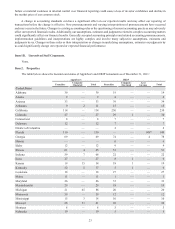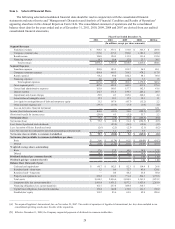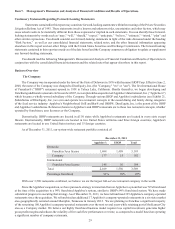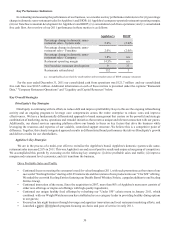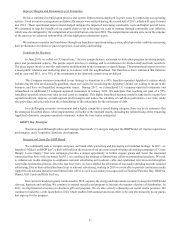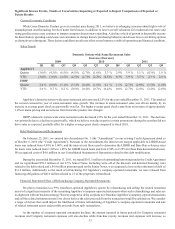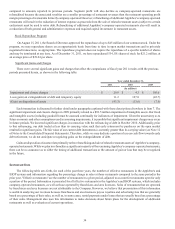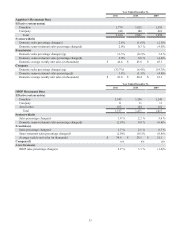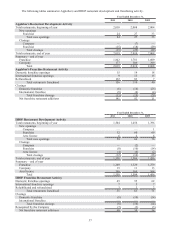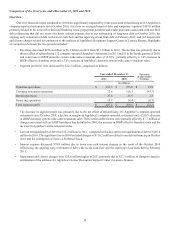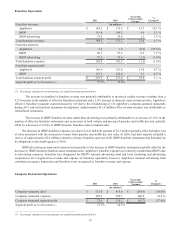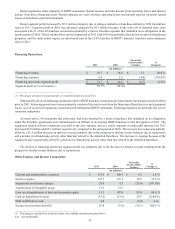IHOP 2011 Annual Report Download - page 49
Download and view the complete annual report
Please find page 49 of the 2011 IHOP annual report below. You can navigate through the pages in the report by either clicking on the pages listed below, or by using the keyword search tool below to find specific information within the annual report.
31
Improve Margins and Restaurant Level Economics
We have continued to build upon process and system improvements deployed in prior years by improving our operating
metrics. Food inventory management and labor efficiencies were realized during the second half of 2011, which will carry forward
into 2012. These operational improvements helped mitigate the impact of increasing commodity costs and higher payroll taxes.
We continued to reap the benefits of our supply chain co-op to leverage our scale to manage through commodity cost inflation,
which was also mitigated by the realignment of our distribution centers in 2010. The margin improvements were not at the expense
of the guest as we achieved system-wide all-time high guest satisfaction scores.
We continue to monitor our franchisees through our franchisee operations rating system, which provides visibility concerning
their performance in relation to guest experience, food safety and training.
Transform the Business
In June 2010, we rolled out “Connections,” the new comprehensive restaurant revitalization program involving people,
place and promotional aspects. The people aspect involves re-training and re-certification for kitchen staff and team members.
The place aspect involves exterior and interior modifications to the restaurant to signal change. The promotional aspect involves
a local public relations and marketing plan to re-connect with the neighborhood. Our franchisees have embraced this initiative
and by year-end 2011, over 30% of the restaurants in the domestic system were revitalized.
The Company remains committed to our strategy to transition to a 99% franchise-operated Applebee's system which
includes buyers who are financially qualified, share our vision for revitalizing the Applebee's brand, are willing to invest in the
business, and have well-qualified management teams. During 2011, we refranchised 132 company-operated restaurants and
refranchised an additional 17 company-operated restaurants in January 2012. We anticipate that reaching our goal of a 99%
franchisee-operated system may take several years to complete. This highly franchised business model is expected to require less
capital investment, improve overall segment profit margins and reduce the volatility of cash flow performance over time, while
also providing cash proceeds from the refranchising of the restaurants for the retirement of debt.
In a challenging economic environment and a highly competitive casual dining category, there can be no assurance that
the strategies described above, when implemented, will achieve the intended results, including the refranchising of the remaining
Applebee's domestic company-operated restaurants, within the time frame anticipated.
IHOP's Key Strategies
We pursue growth through a three-part strategic framework: (1) energize and grow the IHOP brand; (2) improve operations
performance; and (3) optimize franchise development.
Energize and Grow the IHOP Brand
We continually seek to energize and grow our brand while protecting and leveraging our breakfast heritage. In 2011, we
launched “Make it an IHOP day”, which will build on the success of our previous award-winning advertising campaign of “Come
Hungry. Leave Happy.” Our new campaign provides a unique opportunity to further engage guests and foster the emotional
connection they have with our brand. In 2011, we continued the strategy of limited time offers on promotional products. We seek
to enhance our media strategies to emphasize national advertising on broadcast, cable and syndicated television and strengthen
our product promotion process. Over the last four years, we have shifted the allocation of our media spending towards national
advertising. Due to this reallocation from local to national advertising, starting in 2010 we were able to provide continuous media
support for all national initiatives and limited time offers, as well as secondary messages such as National Pancake Day, IHOP for
Dinner, Gift Cards and Kids Eat Free.
Our current remodel program, commenced in 2010, captures the energy and innovation necessary to keep the IHOP brand
relevant, dynamic and enticing. We continue to expand our gift card program to increase the number of points of distribution. In
2011, we implemented a business-to-business gift card program. We are also actively enhancing our social media presence. We
continue to build the e-club, launched in 2010, which enables both national and local offers to be sent electronically to our guests
that sign up for the program.




